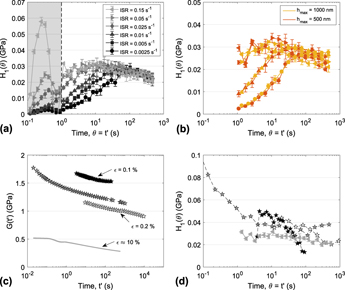Crossref Citations
This article has been cited by the following publications. This list is generated based on data provided by
Crossref.
Baral, P.
Guillonneau, G.
Kermouche, G.
Bergheau, J.-M.
and
Loubet, J.-L.
2019.
A new long-term indentation relaxation method to measure creep properties at the micro-scale with application to fused silica and PMMA.
Mechanics of Materials,
Vol. 137,
Issue. ,
p.
103095.
Smerdova, Olga
Pecora, Marina
and
Gigliotti, Marco
2019.
Cyclic indentation of polymers: Instantaneous elastic modulus from reloading, energy analysis, and cyclic creep.
Journal of Materials Research,
Vol. 34,
Issue. 21,
p.
3688.
Baral, P.
Fradet, C.
Lacroix, F.
Le Bourhis, E.
Guillonneau, G.
Kermouche, G.
Bergheau, J.-M.
and
Loubet, J.-L.
2020.
Extrinsic Measurement of Carbon Black Aggregate Distribution within a Fluoroelastomer Matrix from Nanoindentation Experiments.
ACS Applied Materials & Interfaces,
Vol. 12,
Issue. 5,
p.
6716.
Baral, Paul
Kermouche, Guillaume
Guillonneau, Gaylord
Tiphene, Gabrielle
Bergheau, Jean-Michel
Oliver, Warren C.
and
Loubet, Jean-Luc
2020.
Indentation creep vs. indentation relaxation: A matter of strain rate definition?.
Materials Science and Engineering: A,
Vol. 781,
Issue. ,
p.
139246.
Baral, Paul
Orekhov, Andrey
Dohmen, Ralf
Coulombier, Michaël
Raskin, Jean Pierre
Cordier, Patrick
Idrissi, Hosni
and
Pardoen, Thomas
2021.
Rheology of amorphous olivine thin films characterized by nanoindentation.
Acta Materialia,
Vol. 219,
Issue. ,
p.
117257.
Liang, Z. Y.
Xiang, S. S.
and
Pharr, G. M.
2021.
Effects of crystal orientation on the indentation creep of β-tin.
Journal of Materials Research,
Vol. 36,
Issue. 12,
p.
2434.
Akatsu, Takashi
Akimoto, Yoshihiro
Sasaki, Ryo
Shinoda, Yutaka
and
Wakai, Fumihiro
2022.
Numerical analysis of point-sharp indentation-load relaxation simulated using the finite-element method to characterize the power-law creep deformation of a visco-elastoplastic solid.
International Journal of Solids and Structures,
Vol. 238,
Issue. ,
p.
111417.
Gonabadi, Hassan
Yadav, Arti
and
Bull, Steve
2022.
Contact Problems for Soft, Biological and Bioinspired Materials.
Vol. 15,
Issue. ,
p.
139.
Kiener, Daniel
Wurmshuber, Michael
Alfreider, Markus
Schaffar, Gerald J.K.
and
Maier-Kiener, Verena
2023.
Recent advances in nanomechanical and in situ testing techniques: Towards extreme conditions.
Current Opinion in Solid State and Materials Science,
Vol. 27,
Issue. 6,
p.
101108.
Lang, Lizhong
Liu, Zhiying
Lyu, Tianyi
and
Zou, Yu
2024.
Steady-state nanoindentation creep test on β-Sn: A modified constant contact pressure method.
Journal of Materials Research,
Vol. 39,
Issue. 6,
p.
881.
Liu, Yizhou
Ding, Yanhuai
Yin, Boyuan
Gao, Meng
and
Xu, Fu
2025.
Revealing structural evolution during stress relaxation in metallic glass by nanoindentation and molecular dynamic simulation.
Journal of Non-Crystalline Solids,
Vol. 656,
Issue. ,
p.
123483.
Smerdova, Olga
2025.
A comprehensive study of simulated cyclic indentation response of linear viscoelastic materials.
Continuum Mechanics and Thermodynamics,
Vol. 37,
Issue. 2,
